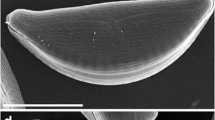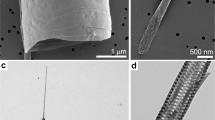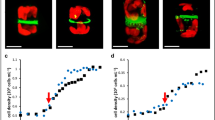Summary
The development of the wall of synchronized culture ofN. pelliculosa is described. The first step, modification of the 3-2 configuration of the girdle bands of the wall during interphase, occurs immediately before mitotic division by the addition of a third girdl band to the hypotheca. Following cytokenesis, the new valve is initiated when a primary central band is formed within a silica deposition vesicle. This band extends the length of the cell and contains a central nodule. Secondary arms extend from the central nodule, join with extensions of the primary central band, and constitute the raphe rib. Mounds or knolls are formed on the central nodule and disappear as the valve matures. Transapical ribs appear on both the primary central band and secondary arms, and cross extensions join to form the sieve plate areas. The wall appears to be released by a joining of the inner silicalemma and the plasmalemma. An organic coat covers the newly released wall. Two girdle bands are formed and released sequentially.
Similar content being viewed by others
References
Azam, F., B. B. Hemmingsen, andB. E. Volcani, 1974: Role of silicon in diatom metabolism. V. Silic acid transport and metabolism in the heterotrophic diatomNitzschia alba. Arch. Microbiol.97, 103–114.
Cachon, P. J., etM. Cachon, 1972: Les modalites du dépôt de la silice chez les radiolaires. Arch. Protistenk.114, 1–13.
Chiappino, M. L., F. Azam, andB. E. Volcani, 1977: Effect of germanic acid on developing cell walls of diatoms. Protoplasma93, 191–204.
Darley, W. M., andB. E. Volcani, 1971: Synchronized cultures: diatoms. In: Methods in enzymology (San Pietro, A., ed.), Vol. XXIII, Part A, pp. 85–96. New York: Academic Press.
Darragh, P. J., A. J. Gaskin, B. C. Terrell, andJ. V. Sanders, 1966: Origin of precious opal. Nature209, 13–16.
Dawson, P., 1973: Observations on the structure of some forms ofGomphonema parvulum Kutz. III. Frustule formation. J. Phycol.9, 353–365.
Doggenweiler, C. F., andJ. E. Heuser, 1967: Ultrastructure of the prawn nerve sheaths. Role of fixative and osmotic pressure in vesiculation of thin cytoplasmic laminae. J. Cell Biol.34, 407–420.
Geitler, L., 1963: Alle Schalenbildungen der Diatomeen treten als Folge von Zelloder Kernteilungen auf. Ber. dts. bot. Ges.75, 393–396.
Hecky, R. E., K. Mopper, P. Kilham, andE. T. Degens, 1973: The amino acid and sugar composition of diatom cell walls. Mar. Biol.19, 323–331.
Iler, R. K., 1955: The colloid chemistry of silica and the silicates. New York: Cornell Univ. Press.
Jones, L. H. P., A. A. Milne, andJ. V. Sanders, 1966: Tabashir: an opal of plant origin. Science151, 464–466.
Kamatani, A., 1971: Physical and chemical characteristics of biogenous silica. Mar. Biol.8, 89–95.
Lauritis, J. A., J. Coombs, andB. E. Volcani, 1968: Studies on the biochemistry and fine structure of silica shell formation in diatoms. IV. Fine structure of the apochlorotic diatomNitzschia alba Lewin and Lewin. Arch. Mikrobiol.62, 1–16.
Lowenstam, H. A., 1971: Opal precipitation by marine gastropods (Mollusca). Science171, 487–490.
Nakajima, T., andB. E. Volcani, 1969: 3,4-Dihydroxyproline: a new amino acid in diatom cell walls. Science164, 1400–1401.
—, 1970: ɛ-N-trimethyl-L-δ-hydroxylysine phosphate and its nonphosphorylated compound in diatom cell walls. Biochem. biophys. Res. Commun.39, 28–33.
Pickett-Heaps, J. D., K. L. McDonald, andD. H. Tippit, 1975: Cell division in the pennate diatomDiatoma vulgare. Protoplasma86, 205–242.
Reimann, B. E. F., 1964: Deposition of silica inside a diatom cell. Exp. Cell Res.34, 605–608.
—,J. C. Lewin, andB. E. Volcani, 1965: Studies on the biochemistry and fine structure of silica shell formation in diatoms. I. The structure of the cell wall ofCylindrotheca fusiformis Reimann and Lewin. J. Cell Biol.24, 39–55.
—, 1966: Studies on the biochemistry and fine structure of silica shell formation in diatoms. II. The structure of the cell wall ofNavicula pelliculosa (Brèb.) Hilse. J. Phycol.2, 74–84.
Reynolds, E. S., 1963: The use of lead citrate at high pH as an electron-opaque stain in electron microscopy. J. Cell Biol.17, 208–212.
Rosenbluth, J., 1963: Contrast between osmium-fixed and permanganate-fixed toad spinal ganglia. J. Cell Biol.16, 143–157.
Round, F. E., 1972: The formation of girdle, intercalary bands and septa in diatoms. Nova Hedwigia XXIII, 449–463.
Simpson, T. L., andC. A. Vaccaro, 1974: An ultrastructural study of silica deposition in the freshwater spongeSpongilla lacustris. J. Ultrastruct. Res.47, 296–309.
Stoermer, E. F., H. S. Pankratz, andC. C. Bowen, 1965: Fine structure of the diatomAmphipleura pellucida. II. Cytoplasmic fine structure and frustule formation. Amer. J. Bot.52, 1067–1078.
Stosch, H. A. v., andK. Kowallik, 1969: Der vonL. Geitler aufgestellte Satz über die Notwendigkeit einer Mitose für jede Schalenbildung von Diatomeen. Beobachtungen über die Reichweite und Überlegungen zu seiner zellmechanischen Bedeutung. Österr. bot. Z.116, 454–474.
Sullivan, C. W., 1976: Diatom mineralization of silicic acid. I. Si(OH)4 transport characteristics inNavicula pelliculosa. J. Phycol.12, 390–396.
—, 1977: Diatom mineralization of silicic acid. II. Regulation of Si(OH)4 transport rates during the cell cycle ofNavicula pelliculosa. J. Phycol.13, 89–91.
Author information
Authors and Affiliations
Rights and permissions
About this article
Cite this article
Chiappino, M.L., Volcani, B.E. Studies on the biochemistry and fine structure of silicia shell formation in diatoms VII. Sequential cell wall development in the pennateNavicula pelliculosa . Protoplasma 93, 205–221 (1977). https://doi.org/10.1007/BF01275654
Received:
Accepted:
Issue Date:
DOI: https://doi.org/10.1007/BF01275654




